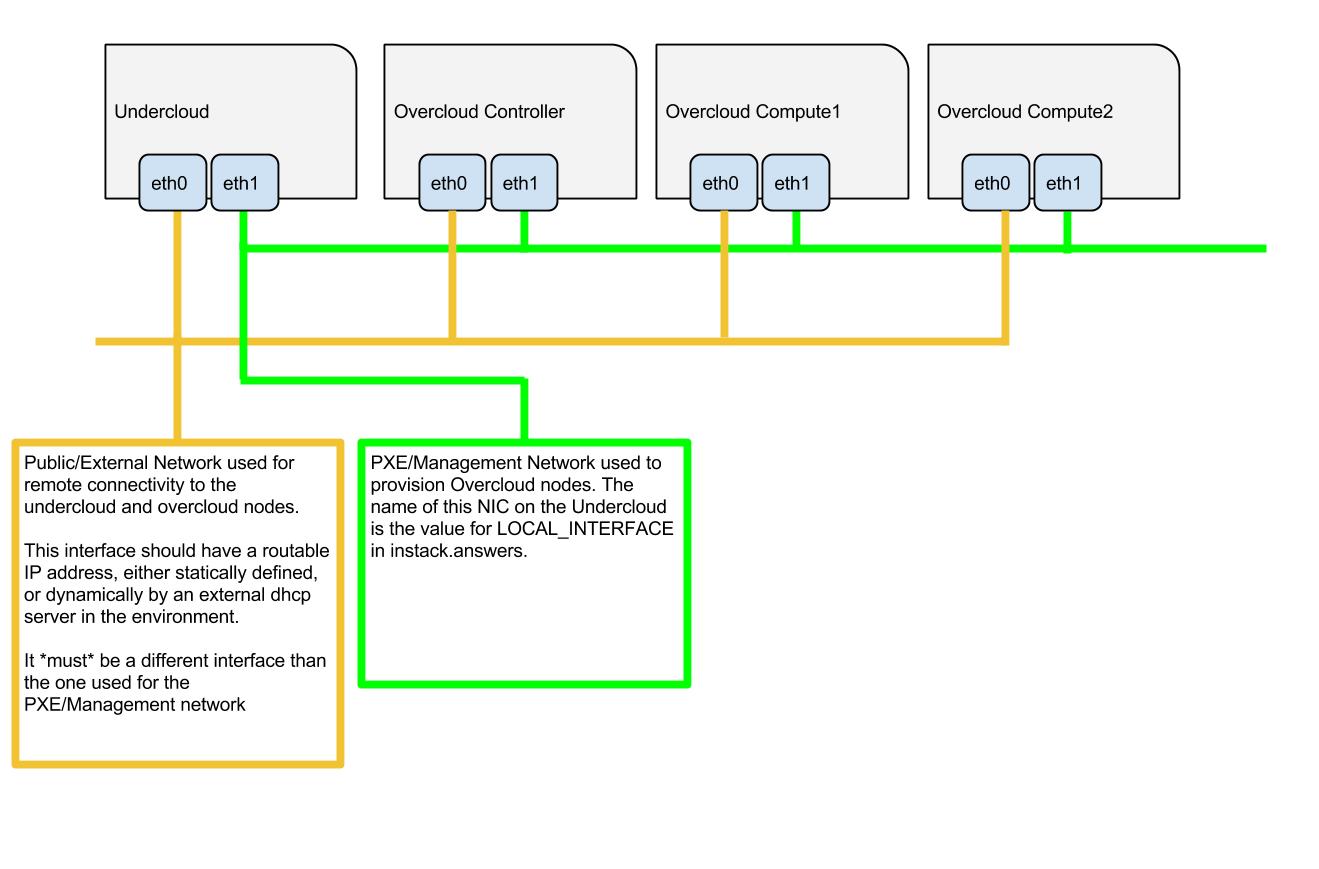Document how to use a satellite for registration. Adds support to instack-deploy-overcloud for enabling the satellite registration via environment variables. Change-Id: I9c1d36eab7166b135c4ede32627f0e3543da2bb5
6.2 KiB
Baremetal Environment
RDO-Manager can be used in an all baremetal environment. One machine will be used for Undercloud, the others will be used for your Overcloud.
Minimum System Requirements
To deploy a minimal RDO cloud with RDO-Manager you need the following baremetal machines:
- 1 Undercloud (where RDO-Manager lives)
- 1 Overcloud Controller
- 1 Overcloud Compute
For each additional Overcloud role, such as Block Storage or Object Storage, you need an additional baremetal machine.
The baremetal machines must meet the following minimum specifications:
- multi-core CPU
- 4 GB memory
- 60 GB free disk space
RDO-Manager is supporting only the following operating systems:
- RHEL 7.1 x86_64 or
- CentOS 7 x86_64
Preparing the Baremetal Environment
Networking
The overcloud nodes will be deployed from the undercloud machine and therefore the machines need to have have their network settings modified to allow for the overcloud nodes to be PXE boot'ed using the undercloud machine. As such, the setup requires that:
- All overcloud machines in the setup must support IPMI
- A management provisioning network is setup for all of the overcloud machines. One NIC from every machine needs to be in the same broadcast domain of the provisioning network. In the tested environment, this required setting up a new VLAN on the switch. Note that you should use the same NIC on each of the overcloud machines ( for example: use the second NIC on each overcloud machine). This is because during installation we will need to refer to that NIC using a single name across all overcloud machines e.g. em2
- The provisioning network NIC should not be the same NIC that you are using for remote connectivity to the undercloud machine. During the undercloud installation, a openvswitch bridge will be created for Neutron and the provisioning NIC will be bridged to the openvswitch bridge. As such, connectivity would be lost if the provisioning NIC was also used for remote connectivity to the undercloud machine.
- The overcloud machines can PXE boot off the NIC that is on the private VLAN. In the tested environment, this required disabling network booting in the BIOS for all NICs other than the one we wanted to boot and then ensuring that the chosen NIC is at the top of the boot order (ahead of the local hard disk drive and CD/DVD drives).
- For each overcloud machine you have: the MAC address of the NIC that will PXE boot on the provisioning network the IPMI information for the machine (i.e. IP address of the IPMI NIC, IPMI username and password)
Refer to the following diagram for more information
Setting Up The Undercloud Machine
Select a machine within the baremetal environment on which to install the undercloud.
Install RHEL 7.1 x86_64 or CentOS 7 x86_64 on this machine.
If needed, create a non-root user with sudo access to use for installing the Undercloud:
sudo useradd stack sudo passwd stack # specify a password echo "stack ALL=(root) NOPASSWD:ALL" | sudo tee -a /etc/sudoers.d/stack sudo chmod 0440 /etc/sudoers.d/stackCreate a json file describing your baremetal nodes. For example:
{ "nodes":[ { "pm_type":"pxe_ipmitool", "mac":[ "fa:16:3e:2a:0e:36" ], "cpu":"2", "memory":"4096", "disk":"40", "arch":"x86_64", "pm_user":"admin", "pm_password":"password", "pm_addr":"10.0.0.8" }, { "pm_type":"pxe_ipmitool", "mac":[ "fa:16:3e:da:39:c9" ], "cpu":"2", "memory":"4096", "disk":"40", "arch":"x86_64", "pm_user":"admin", "pm_password":"password", "pm_addr":"10.0.0.15" }, { "pm_type":"pxe_ipmitool", "mac":[ "fa:16:3e:51:9b:68" ], "cpu":"2", "memory":"4096", "disk":"40", "arch":"x86_64", "pm_user":"admin", "pm_password":"password", "pm_addr":"10.0.0.16" } ] }
external
RHEL
If using RHEL, reigster the Undercloud for package installations/updates.
RHEL Portal Registration
Register the host machine using Subscription Management:
sudo subscription-manager register --username="[your username]" --password="[your password]" # Find this with `subscription-manager list --available` sudo subscription-manager attach --pool="[pool id]" # Verify repositories are available sudo subscription-manager repos --list # Enable repositories needed sudo subscription-manager repos --enable=rhel-7-server-rpms \ --enable=rhel-7-server-optional-rpms --enable=rhel-7-server-extras-rpms \ --enable=rhel-7-server-openstack-6.0-rpmsRHEL Satellite Registration
To register the host machine to a Satellite, the following repos must be synchronized on the Satellite and enabled for registered systems:
rhel-7-server-rpms rhel-7-server-optional-rpms rhel-7-server-extras-rpms rhel-7-server-openstack-6.0-rpmsSee the Red Hat Satellite User Guide for how to configure the system to register with a Satellite server. It is suggested to use an activation key that automatically enables the above repos for registered systems.
